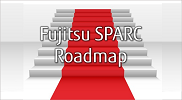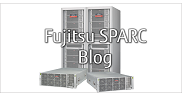Archived content
NOTE: this is an archived page and the content is likely to be out of date.
Why is it Important for Hardware and Software Teams to Work Closely Together?

Even with revolutionary hardware technology, close collaboration with firmware and software is required in order to deliver the full capabilities of a modern server. Fujitsu M10 server hardware, firmware, and software developers work closely together as a team to deliver strong product value. Their efforts to develop high performance, highly flexible, and highly available servers continue.
Developing Virtualization Technologies that Enhance the Value of Oracle Solaris

Kazuhiro Nakamura
Kazuhiro Nakamura has spent his entire career in the development of UNIX operating systems and is engaged in the development of Oracle Solaris and Oracle VM Server for SPARC (hereafter "Oracle VM") for Fujitsu M10 servers.
The history of Fujitsu UNIX servers began with the Fujitsu DS/90 7000 series released in 1991. In 1998 the GP7000F server family running Oracle Solaris was released, and Fujitsu's development of SPARC/Solaris servers has continued ever since, with customers benefiting from Fujitsu UNIX server technology around the world.
With a strong alliance with Oracle Corporation (hereafter "Oracle"), Fujitsu has developed Oracle Solaris functions for Fujitsu processors and server hardware. Our Fujitsu development sites are located in Japan and Silicon Valley. Having a development site close to Oracle headquarters enables us to add functionality that is optimized for Fujitsu hardware more smoothly.
At present, I am working in the development team here in Japan, but I have been stationed at the Fujitsu Silicon Valley Campus twice previously. Oracle appreciates Fujitsu's technological capabilities, and we have established a very good relationship.
Fujitsu's technological capabilities are also evident in the customer support we provide in Japan. Our frontline Operation & Maintenance Service Support Desk has a great deal of Oracle Solaris knowledge and can answer 95% of customer inquiries. Of the remaining 5% of inquiries which are referred to our development teams, 80% can be resolved within Fujitsu. The remaining 20% (1% of all inquiries), are escalated to Oracle. In other words, 99% of Oracle Solaris customer inquiries are solved by Fujitsu.

Oracle Solaris itself has many advantages, including: binary compatibility, long-term support, stable operation under high load, included no-cost virtualization functions, etc. Fujitsu hardware, software and firmware development teams collaborate in many areas with a focus on delivering a server product line specifically designed to provide linear performance improvement as the server hardware scales from small to huge. With Fujitsu M10 servers, the collaboration between hardware, software and firmware is advanced in order to create new value for our customers.
The Fujitsu M10 Software on Chip features is a good example of the success of strong collaboration. Software on Chip is a collection of technologies that accelerate the processing speed of specific processes previously handled by software. This is done by implementing specialized logic directly in the processor itself. Implementing these functions required support from the processor, operating system, and Oracle Database development teams.
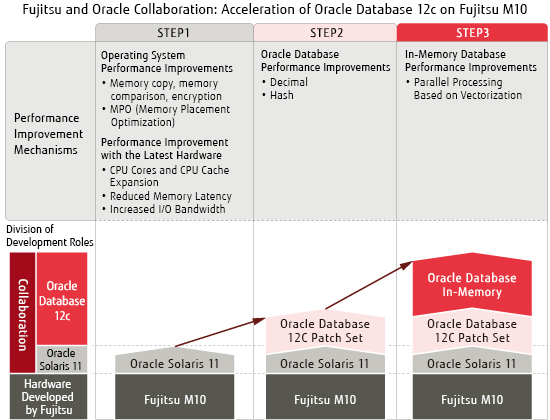
Fujitsu's processor development teams have full knowledge of how instructions are effectively executed to make software run faster, and collaborate closely with our operating system development teams. Through discussion and close collaboration with Oracle developers, Oracle Database 12c has been optimized for our decimal floating-point arithmetic processing function with support for Oracle Number.
The result of this collaborative effort is significant database performance improvements from the combination of Fujitsu M10 Software on Chip, Oracle Solaris 11, and Oracle Database 12c. We achieved further performance improvements with Oracle Database In-Memory (STEP3 in the diagram above).
Fujitsu derives strength, and ultimately results, from the close and face-to-face collaboration of hardware and software developers. In addition, having Fujitsu developers located close to Oracle is important for improving database performance. The presence of the Fujitsu Silicon Valley Campus is extremely beneficial. Of course with today's technology we can communicate and have meetings remotely, but face-to-face collaboration can achieve faster and better results through rapid feedback and deeper understanding of each other.
Another example of collaboration between hardware and software is virtualization, specifically Oracle VM. Previous SPARC Enterprise M-series servers had two types of virtualization functions: hardware partitioning and Oracle Solaris Zones. With Fujitsu M10, Oracle VM has been added for even more flexibility, allowing higher utilization rates and cost-saving server consolidation. Oracle VM is a firmware-level virtualization function developed by Oracle and first implemented on SPARC T-series servers. Fujitsu collaborated with Oracle in order to support this function on Fujitsu M10. Multiple domains (each a separate Oracle Solaris environment) can be created on one chassis, and different versions of Solaris can be mixed. Despite a short development period, we successfully added functions to Oracle VM that were requested by our customers and not available on other servers. Such functions include core auto-replacement, hypervisor dump collection, and prioritized shutdown.
The ability of Fujitsu engineers to develop high quality software in a short timeframe was favorably received at Oracle, and our contributions have been welcomed as valuable enhancements to Oracle Solaris and Oracle VM.
Fujitsu-Quality Maintained for Complex Virtualized Systems

Hiroyuki Watanabe
Mr. Watanabe is a developer of firmware for UNIX servers and supercomputers. Firmware controls servers at the layer between hardware and software in order to fully utilize hardware functionality.
In the Fujitsu firmware development teams, we work closely with the hardware teams in order to provide customers with highly functional server systems.
I have experience in developing not only UNIX servers but also supercomputers. These two types of machines are both high-end servers, but the differences in their design concepts are often apparent. Quality is of course important for supercomputers, but higher priority is given to performance. In case of failure, a supercomputer continues processing with the failed node disconnected, with the goal of maintaining performance across the entire system.
However, for UNIX servers used in business applications, top priority is given to business continuity. Hardware is monitored and controlled, mainly through the service processor (XSCF), and measures are taken to prevent the system from stopping.
The extremely strong focus on quality, a unique characteristic of Fujitsu, constantly flows in from our mainframe development mentality. With the addition of the Oracle VM virtualization and Building Block architecture to Fujitsu M10, hardware and software structures have become more complex, and obtaining "Fujitsu-Quality" is therefore more difficult. We persevere in this development, and derive a sense of pride from our accomplishments.
In addition, Fujitsu UNIX servers have supported Dynamic Reconfiguration (hereafter "DR") for multiple generations, since the early years of development. DR is a function that enables hardware resources such as CPUs, memory and I/O devices to be added and deleted to/from physical partitions without stopping the system.
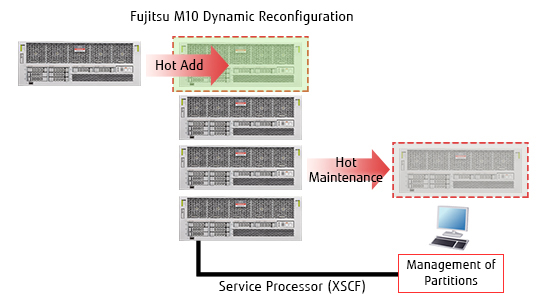
Implementation of DR requires close cooperation between firmware and hardware development teams. For instance, when deleting memory, if data remains in processor cache memory, it can lead to conflicts in subsequent processing. Therefore, a process to synchronize the contents of memory that is subject for deletion with cache memory has been added.
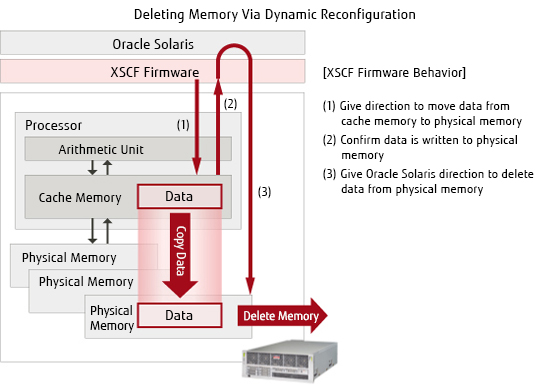
Our processors have a function called "speculative execution" to improve processing speed. This is a mechanism to predict the next instructions and then execute them ahead of time. Put another way, these instructions are executed by processors before software gives the direction to do so. When deleting processors using DR, these scenarios are considered and appropriate measures are taken by firmware to avoid adverse impacts.
At Fujitsu, hardware development teams are located close to our firmware teams so we can more easily cooperate in implementing DR. This allows us to promptly provide high quality functions that competitors cannot easily match. It is likely that these functions could not have been implemented if other vendors' processors were used.
DR on Fujitsu M10 is used by many customers around the world with large-scale system configurations. Developers like me are proud to see our efforts being used broadly.
Aiming for Easy Operation and Management

Yuichi Musha
With experience in the development of UNIX server management software and SPARC T-series server support, Mr. Musha was given the mission to develop Fujitsu M10 support in Oracle Enterprise Manager Ops Center 12c (hereafter "Ops Center"), Oracle's operation management software for SPARC/Solaris servers.
Ops Center is software that enables integrated management of SPARC/Solaris server hardware and virtual environments from a browser (GUI screen).
Fujitsu M10 has a layered structure based on three types of server virtualization: hardware partitioning, Oracle VM, and Oracle Solaris Zones. Fujitsu M10 is the first server with three-layered virtualization that is manageable by Ops Center. Our development began with the goal of allowing customers to easily use multi-layered virtualization management functions.
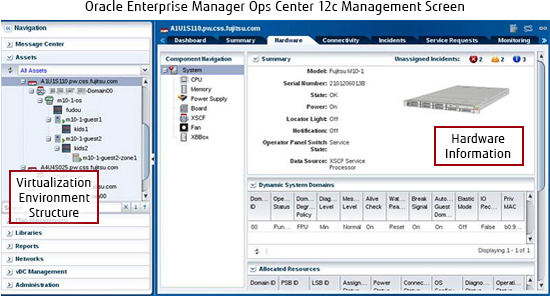
For developers like me, experiencing the environment of innovation in Silicon Valley is just as exciting as playing Major League Baseball. Face-to-face discussions with excellent engineers from around the world and creating software modules was very demanding, but it was also an enjoyable assignment like nothing I had previously experienced.
Because the time allotted for development was short, finishing everything within the time limit was initially considered difficult. However, by utilizing the development skills and process management methods acquired in the development of other Fujitsu software, we were able to successfully complete Fujitsu M10 support in Ops Center. We attained excellent quality and also received acclaim from Oracle.
Before this product became publicly available, I had the opportunity to visit Kuwait to support the implementation of a customer's system. I helped with the installation and configuration of the operating system and Oracle VM, but I felt that if only Ops Center were available, I could create domains just by following the GUI screen to specify the number of CPUs and memory...
I believe that customers who consider Oracle VM commands difficult will appreciate the convenience of the GUI.
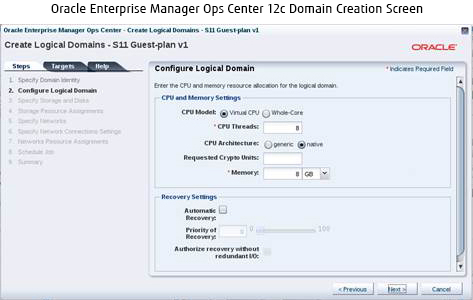
Nowadays, I have more opportunities to introduce Ops Center directly to our customers, show them the benefits and listen to their needs. Our joint development continues as we strive to make Oracle VM even more convenient with useful GUI functions.
Engineers of Fujitsu enthusiastically endeavor to develop innovative infrastructure to support our customers' business around the world with their technological capabilities acquired over years of server development and through further cooperation with Oracle.

Kazuhiro Nakamura, Senior Manager
First Development Department
UNIX Software Development Division
Enterprise Server Business Unit

Hiroyuki Watanabe, Manager
Second Development Department
UNIX Software Development Division
Enterprise Server Business Unit

Yuichi Musha
First Development Department
UNIX Software Development Division
Enterprise Server Business Unit
